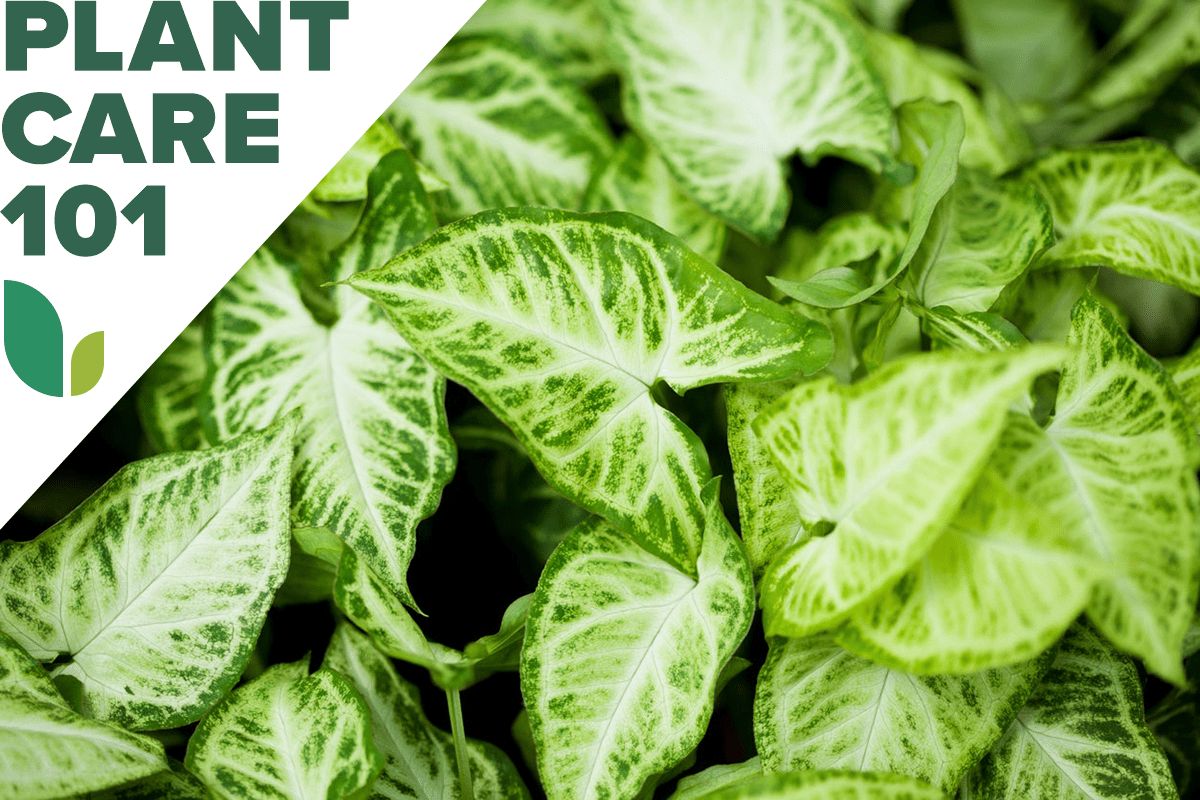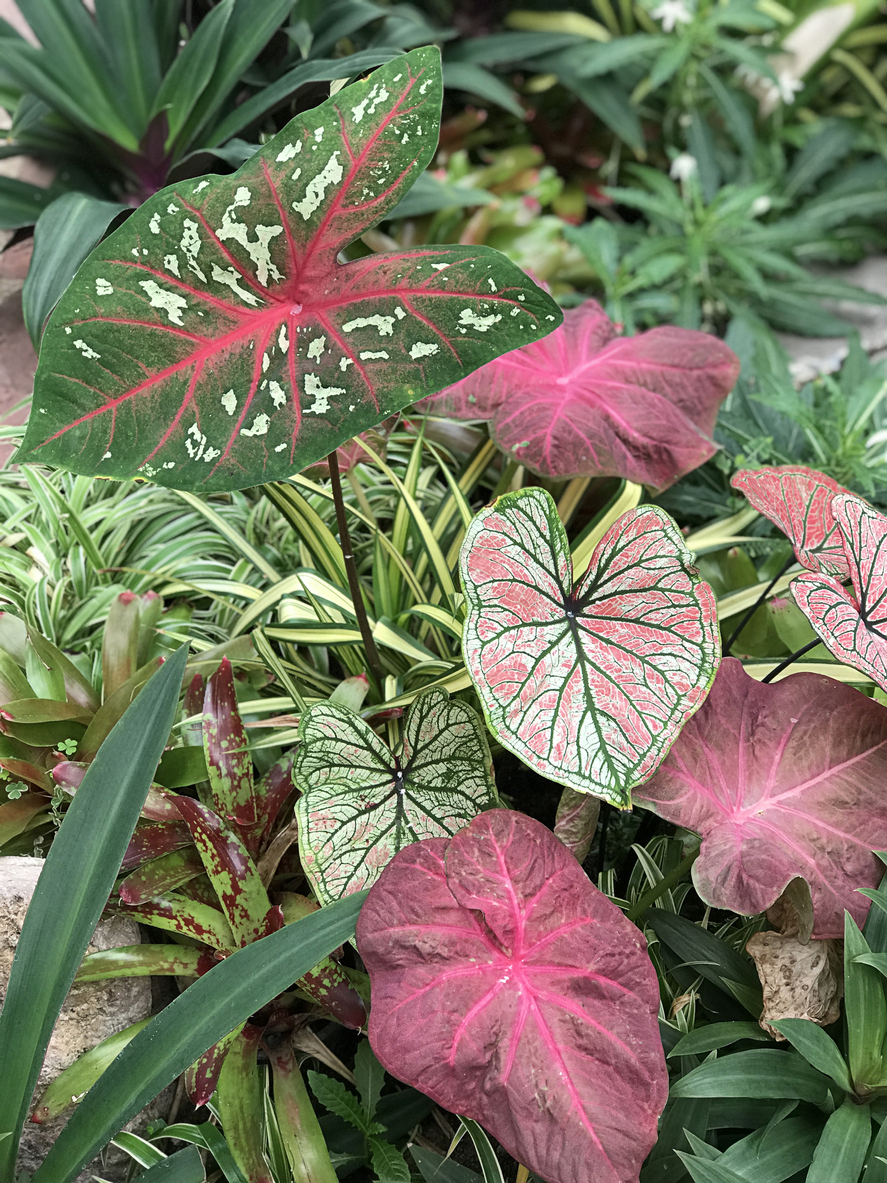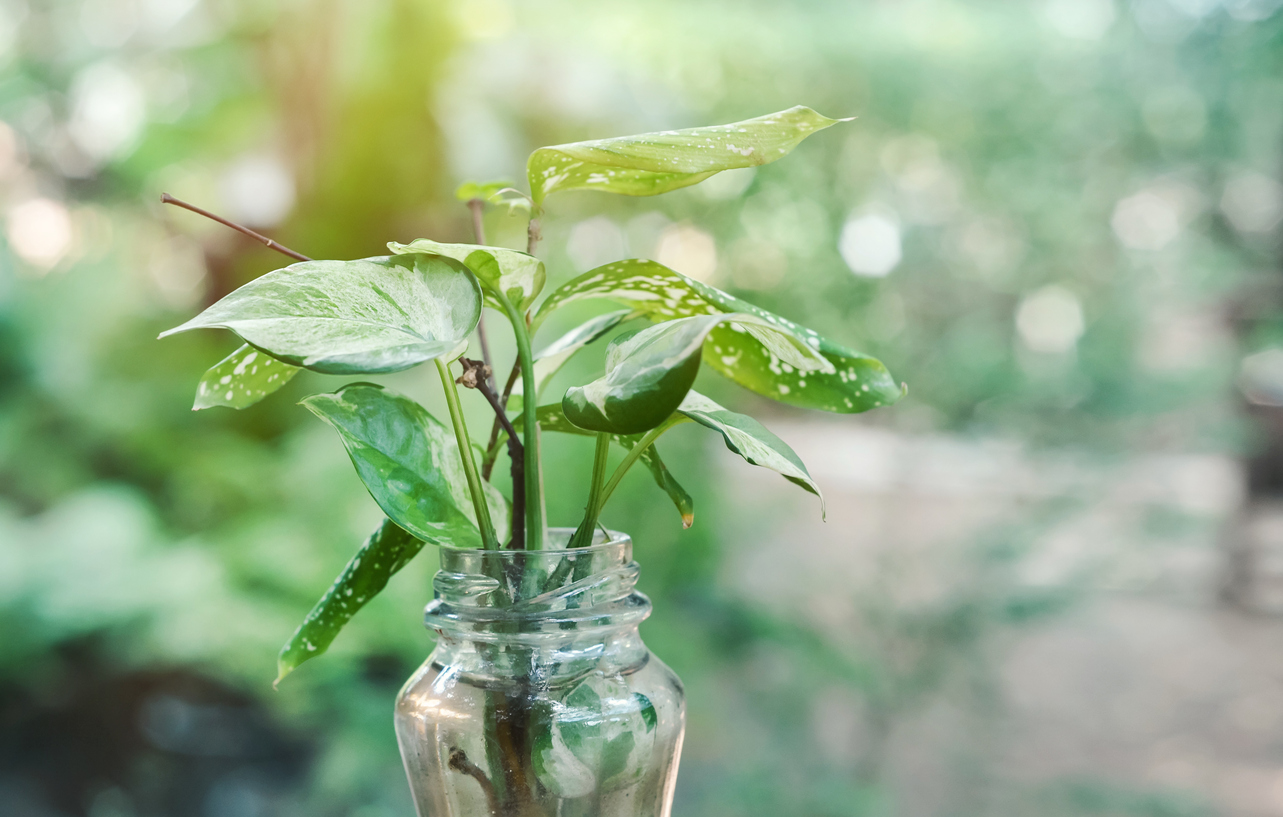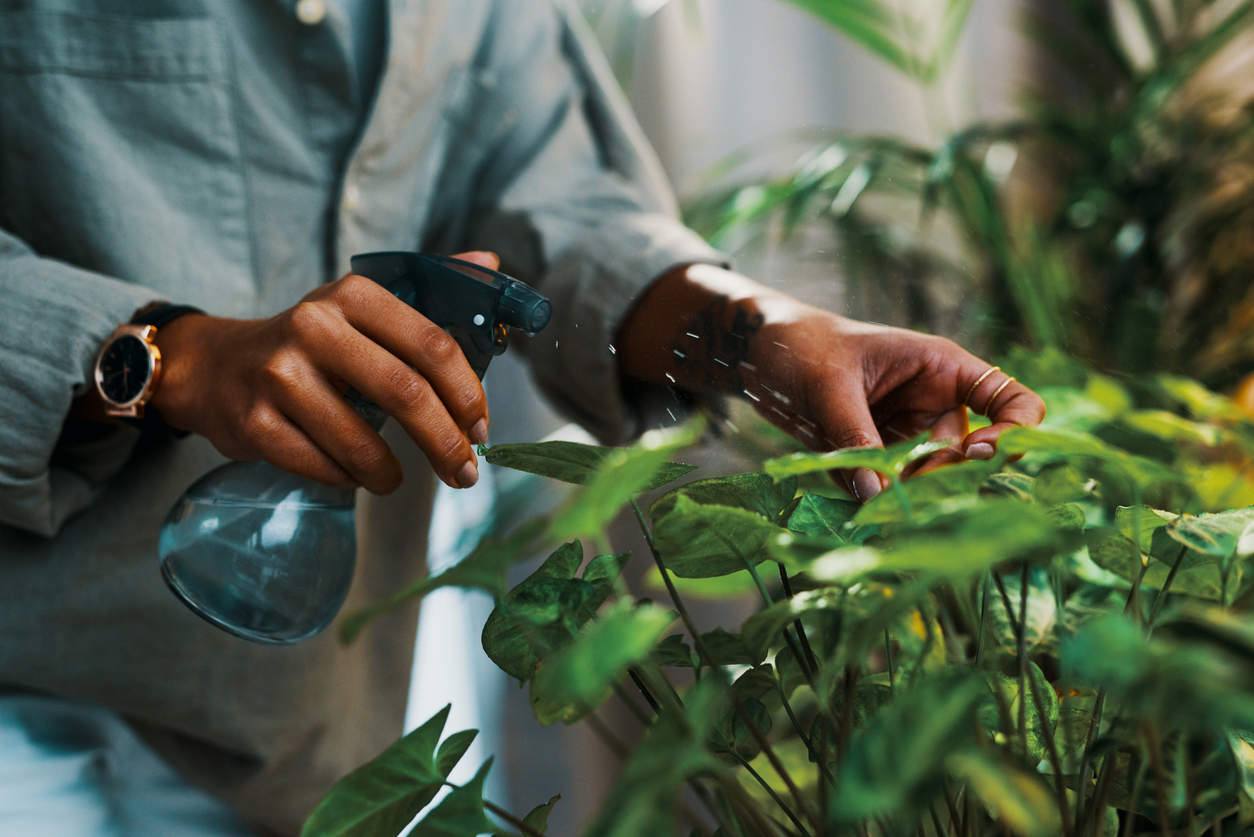

We may earn revenue from the products available on this page and participate in affiliate programs. Learn More ›
If you like to browse plants online or in stores, you are sure to come across an arrowhead plant. This easy-care plant makes an excellent choice for those who are just starting out with houseplants. For experienced gardeners, arrowhead’s lush, colorful foliage and adaptability make it a top choice for arrangements and mixed plantings.
If you’ve just acquired your first Syngonium podophyllum, you’ve come to the right place. Read on to learn everything you’ll need to know about arrowhead plant care.
Arrowhead Plant Care at a Glance
Common Name: Arrowhead Plant
Scientific Name: Syngonium podophyllum
Soil: well-draining potting soil
Light: low to medium indoor light
Water: medium
Food: general purpose houseplant fertilizer
Temperature and Humidity: 65 to 75 degrees Fahrenheit, moderate to high humidity
Propagation: stem cuttings
Safety: stomach irritant, skin irritant
Arrowhead Plant Characteristics
Syngonium podophyllum, commonly known as arrowhead vine or nephthytis, is native to tropical regions from Ecuador to Mexico. The common name of nephthytis comes from an unrelated African plant genus, due to confusion at the time of arrowhead’s discovery by botanists in the mid-1800s. In the wild, this evergreen climber normally grows 3 to 6 feet long in the forest understory. As a houseplant, plant lovers especially like its attractive foliage and easy-to-grow nature.
The leaves display colorful hues of white or pink in many popular cultivars. They actually change shape as they mature. Young leaves are more oval with a distinct heart-shaped base, and mature to a longer arrowhead shape. Rarely in cultivation, small greenish flowers emerge from the leaf axils on a spadix surrounded by a pale green spathe reminiscent of the Peace Lily flower, but smaller. The flowers later give way to dark berries.
Related: 14 of the Fastest-Growing Houseplants for a Nearly Instant Indoor Garden
Types of Arrowhead Plant
- ‘Berry Allusion’ arrowhead plant displays light green leaves with shades of pink and cream.
- ‘Cream Allusion’ arrowhead plant features an especially compact growth habit with creamy-green colored, medium-sized leaves infused with pink tones.
- ‘Maria Allusion’ arrowhead plant has heavily shaded light green leaves with areas of deep coppery pink tones.
‘Painted Arrow’ arrowhead plant shows off creamy green leaves that are edged and splattered with light green. - ‘Pink Allusion’ arrowhead plant exhibits a compact growth habit, and light green leaves with darker green edges accented by pink leaf veins.
- ‘Strawberry Cream’ arrowhead plant produces striking pink new growth in bright growing conditions.
- ‘White Butterfly’ arrowhead plant is one of the most popular cultivars with greenish white leaves edged in dark green.

Selecting Soil for Arrowhead Plants
While arrowhead is not a picky plant, it requires soil with really good drainage. Choose a high-quality potting soil made of coarse materials like peat, perlite, and compost. Be mindful, as the soil particles break down over time and become compacted. Repotting into fresh soil will rejuvenate the root zone.
Some growers prefer to amend regular potting soil for their arrowheads by adding extra perlite, or even orchid bark, to improve the soil’s drainage. This step isn’t necessary, but it can help with the watering schedule if you are balancing the diverse needs of a large plant collection. It may also extend the time between needed repottings.
The Right Light
Arrowhead plants generally have flexible lighting needs. They tolerate low, medium, or bright indirect sunlight, so they can add greenery to most places inside the home. In rooms with south-facing windows, they are best situated near an opposite wall. In rooms that have northern exposure, the plants can grow on windowsills.
Some of the more colorful cultivars, however, need more light to achieve the best coloration. Strawberry Cream is one such example; it grows gorgeous pink new growth in bright light, but in lower light the color fades to a nearly uniform light green. Even so, always avoid direct sunlight on the foliage.
Related: Count On These 25 Indoor Plants for Easy Color Year-Round
Watering Arrowhead Plants
Keep the soil around your plant evenly moist. Plant size, air temperature, light level, humidity, and soil type work together to affect water usage. Rather than committing to a regular watering schedule, feel the soil with your finger every three to five days. The surface may dry out a bit, but just below the surface it should have the feel of a wrung-out sponge. If it is dry, it’s time to water.
Water with a watering can, slowly saturating the soil until water comes out of the pot’s drain holes. Discard the drain water.
Fertilizing Arrowhead Plants
Arrowhead plants are not “hungry” plants, but they benefit from consistent fertilization. Apply general-purpose houseplant food, with a balanced mix such as 10-10-10 or 20-20-20, according to the label instructions.
One of the easiest ways to give arrowhead plants the nutrients they need is by applying a time-release fertilizer three or four times per year. Unlike conventional granular fertilizer, time-release plant food becomes available for plants gradually to feed them over the course of several months.
Another good choice is water-soluble fertilizer. Mix it up according to the label instructions and use the fertilizer solution to replace the scheduled watering, according to the label directions.
Setting the Temperature and Humidity
Arrowhead plants grow best in the same temperatures that people prefer. Set your household thermostat anywhere between 65 and 75 degrees Fahrenheit, and your plant will thrive. If you move your houseplants outdoors during the summer months, the arrowhead will do well. Just be sure to bring it in before the overnight temperatures drop into the 50s and keep it out of direct sun.
Humidity may be a bit more complicated, since these plants prefer a little moisture in the air. Growing them in a bathroom or kitchen can help. Or, use a pebble tray (available on Amazon) to boost the ambient humidity in the area around the plant. Line a large plant saucer with 1/2-inch pebbles, fill it halfway with water, and place the potted plant on top. Do not keep the plant near a heating or air conditioning vent.

Propagating Arrowhead Plants
Use the stem-cutting method to propagate these plants. Take 6- to 12-inch cuttings from healthy, well-established plants. Make the cut just below a node (intersection of a bud or leaf with the stem). Remove leaves from the lower third of the cutting, leaving the top two leaves intact. Insert the stem cutting into either a jar of fresh water or moist potting soil.
For cuttings in water, simply change the water every two or three days. Watch for new roots to emerge in a couple of weeks. About four to six weeks after sticking the cutting in water, it should be ready to pot up into soil.
For soil-based cuttings, it is important to keep the soil moist. It also helps to maintain elevated humidity. You’ll know your cutting has rooted when new leaves begin to emerge.
Safety Considerations
This plant poses a hazard to young children and pets. For one, all parts of the plant contain a known mouth and stomach irritant that causes numbness or tingling in the mouth, upset stomach, nausea, and vomiting if consumed. Also, the sap causes skin irritation for some gardeners. If you have sensitive skin, use gloves when pruning, propagating, or repotting.
Because it rarely blooms indoors, the arrowhead plant does not produce much pollen. It’s considered a low-allergen plant that should be fine for most allergy sufferers.
Related: 20 Low-Light Houseplants You Can Grow Practically Anywhere
Potential Pests and Diseases
On its own, the arrowhead plant rarely has problems with pests or diseases. Grouped with other plants, it might suffer from crossover infestation of common pests such as aphids, mealybugs, scale, or spider mites.
Inspect your plants regularly and treat them promptly if signs of pest problems arise. Remove pests by hand and wipe down stems and foliage with a rubbing alcohol-soaked paper towel. Prune out severely damaged plant parts. Spray with a contact insecticide or miticide such as insecticidal soap or neem oil.

FAQs About Arrowhead Plant Care
Arrowhead plants are popular because of their easy-going nature and pretty foliage. If you have questions about caring for your new specimen, read on.
Q: How big do arrowhead plants get?
These lush, fast-growing vines can achieve a height of 15 to 30 inches. Most growers pinch back the growing tips regularly to keep them compact.
Q: How often should I water my arrowhead plant?
Use your finger to check the soil for dryness. When the upper inch of the soil feels dry to the touch, saturate it to the point of runoff. Let it drain freely and discard the runoff.
Q: How much light does an arrowhead plant need?
Arrowhead plants are flexible in their light tolerance, which ranges from medium to bright indirect light. The more colorful cultivars need bright light to develop the strongest depth of color.
Q: Do arrowhead plants like to be misted?
They benefit from high humidity. Misting is not necessary, but doing so can temporarily boost humidity. A better solution is to use a pebble tray beneath the plant as described above.
